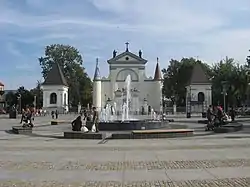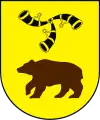Węgrów
Węgrów [ˈvɛŋɡruf] is a town in eastern Poland with 12,561 inhabitants (31 December 2003). Situated in the Masovian Voivodeship (since 1999), it is the capital of Węgrów County.
Węgrów | |
|---|---|
 Baroque Basilica of the Assumption at the Market Square | |
 Coat of arms | |
 Węgrów | |
| Coordinates: 52°24′N 22°1′E | |
| Country | |
| Voivodeship | Masovian |
| County | Węgrów |
| Gmina | Węgrów (urban gmina) |
| Established | 14th century |
| Town rights | 1441 |
| Government | |
| • Mayor | Paweł Marchela |
| Area | |
| • Total | 35.45 km2 (13.69 sq mi) |
| Population (2013[1]) | |
| • Total | 12,796 |
| • Density | 360/km2 (930/sq mi) |
| Time zone | UTC+1 (CET) |
| • Summer (DST) | UTC+2 (CEST) |
| Postal code | 07-100 |
| Area code | +48 25 |
| Car plates | WWE |
| National roads | |
| Voivodeship roads | |
| Website | http://www.wegrow.com.pl |
History
First mentioned in historical records in 1414, Węgrów received its city charter in 1441. Between 16th and 18th centuries it was an important centre for Reformation movements in Poland. It was a private town owned by various Polish nobles, including the Kiszka, Radziwiłł and Krasiński families, administratively located in the Podlaskie Voivodeship in the Lesser Poland Province of the Kingdom of Poland. The local Basilica of the Assumption houses the so-called Twardowski Mirror, a Renaissance mirror from the 16th century associated with the legend of Sir Twardowski.
After the Third Partition of Poland it was annexed by Austria in 1795. It was regained by Poles following the Austro–Polish War of 1809, and included within the short-lived Duchy of Warsaw. After the duchy's dissolution, in 1815, it passed to so-called Congress Poland in the Russian Partition of Poland. During the January Uprising, on February 3, 1863, it was the site of the Battle of Węgrów, in which Polish insurgents defeated Russian troops and captured the town. From 1867 to 1912, Węgrów was part of Siedlce Governorate and from 1912 to 1915 of Łomża Governorate. It became part of independent Poland again when the country regained its independence in 1918. From 1919 to 1938, Węgrów was part of Lublin Voivodeship and from 1938 to 1939 of Warsaw Voivodeship. During the Polish–Soviet War, on August 19, 1920, it was the site of a battle between Poles and the retreating Russian 16th Army.[2]
Throughout most of its history, the town had a thriving Jewish community, present at least since the 16th century. It numbered about 6,000 in 1939. The entire community was exterminated during the Holocaust by the occupying forces of Nazi Germany, during which time the Nazis also created the Węgrów Ghetto.[3]
The town was liberated from German occupation by the Polish underground Home Army in August 1944 during the Operation Tempest.
People from Węgrów
- Krzysztof Filipek, 21st century politician
- Piotr z Goniądza, 16th century religious leader and writer
- Stanisław Kosior, 20th century Soviet politician
- Samuel Rajzman, Holocaust survivor and court witness
References
- Demographic Yearbook of Poland 2014 Archived February 20, 2016, at the Wayback Machine
- Kowalski, Andrzej (1995). "Miejsca pamięci związane z Bitwą Warszawską 1920 r.". Niepodległość i Pamięć (in Polish). Muzeum Niepodległości w Warszawie (2/2 (3)): 167. ISSN 1427-1443.
- Grabowski, Jan (2018). "A Study in the Microhistory of the Holocaust: The Liquidierungsaktion in Węgrów Ghetto A Study in the Microhistory of the Holocaust: The Liquidierungsaktion in Węgrów Ghetto". In Skitolsky, Lissa; Glowacka, Dorota (eds.). New Approaches to an Integrated History of the Holocaust: Social History, Representation, Theory. Lessons and Legacies. Vol. XIII. Northwestern University Press. pp. 141–166. doi:10.2307/j.ctv4t7zgx.11 ISBN 978-0-8101-3768-4
External links
- Official homepage of Węgrów (in Polish)
- Jewish Community in Węgrów on Virtual Shtetl
- Górczyk Wojciech Jerzy, BRIEF HISTORY OF THE CHURCH AND FORMER REFORMATI ORDER'S MONASTERY IN WĘGRÓW, Węgrów 2020.
- Górczyk Wojciech Jerzy, The Former Reformati Order’s Monasteries Route, Węgrów 2020.

